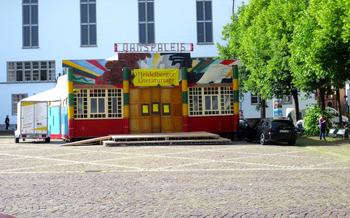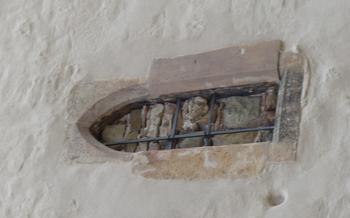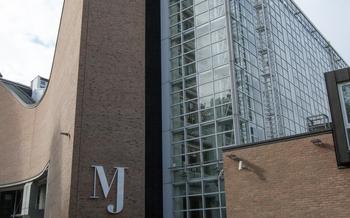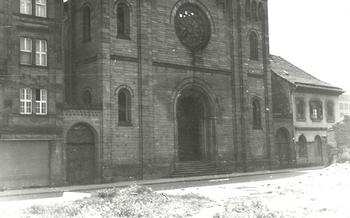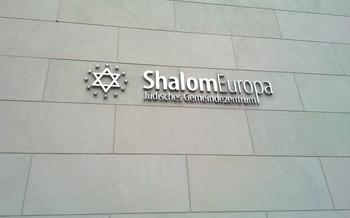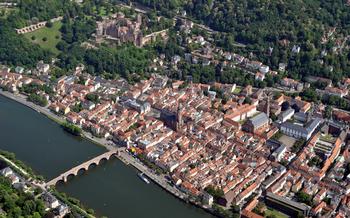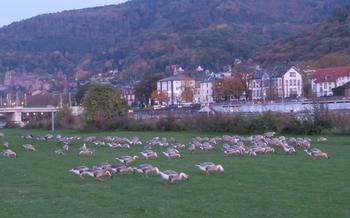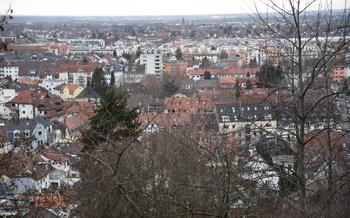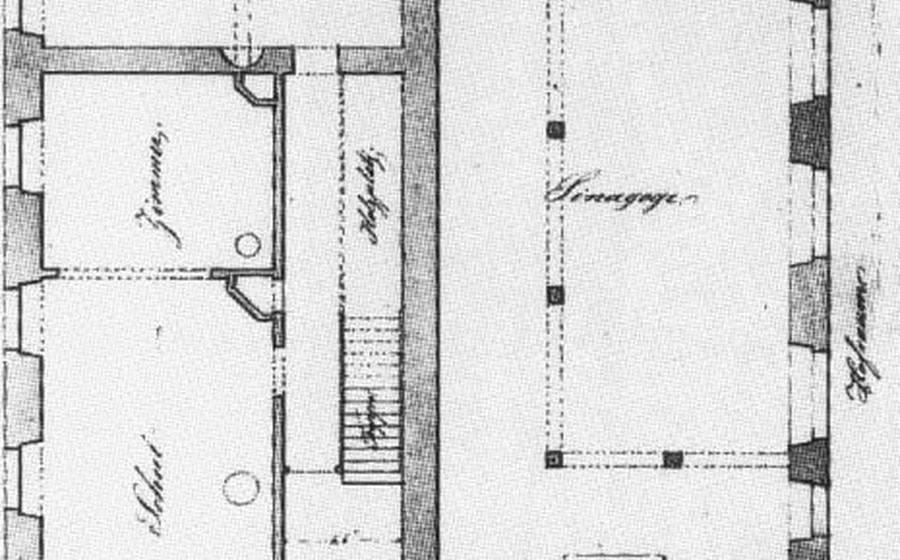
The Old Synagogue
- The Old Synagogue: A Historical Landmark in Heidelberg
- Location and Access:
- History and Background
- Architectural Highlights:
- Interior Features
- Guided Tours
- Exhibitions and Events
- Jewish Cultural Center
- Significance for Jewish Culture
- Personal Stories and Anecdotes
- Visiting Tips for a Respectful Experience
- Surrounding Area: Exploring Heidelberg
- Accessibility
- Insider Tip: The Student Prison
The Old Synagogue: A Historical Landmark in Heidelberg
The Old Synagogue in Heidelberg, Germany stands as a testament to the rich Jewish heritage of the city and the resilience of the Jewish community that once thrived here. Built in 1878 in the late Gothic Revival style, this grand synagogue served as the spiritual and cultural center of Heidelberg's Jewish population for over six decades. Its imposing facade, intricate details, and symbolic ornamentation reflect the significance of this historic landmark.
The synagogue's construction coincided with a period of emancipation for Jews in Germany, when they were finally granted equal rights and opportunities. The grandeur of the building, with its striking spires and majestic arched windows, embodied the newfound confidence and aspirations of the Jewish community. It became a symbol of their newfound freedom and their desire to integrate into German society while preserving their unique identity.
The Old Synagogue's architectural style and design also mirrored the growing influence of historicism in Germany during the 19th century. Historicism, a movement that sought to revive and reinterpret historical architectural styles, influenced the synagogue's design, which drew inspiration from Gothic churches and cathedrals. This choice of architectural style reflected the desire to connect the synagogue to the city's Christian heritage and to emphasize the shared history and culture of Heidelberg's diverse religious communities.
The synagogue's interior, as well as the artistic and decorative elements that adorned it, reflected traditional Jewish motifs and symbolism. The main prayer hall featured a grand vaulted ceiling, intricate stained-glass windows, and ornate chandeliers. The Ark of the Covenant, a sacred cabinet that housed the Torah scrolls, was the focal point of the sanctuary and was elaborately decorated with carvings and inscriptions. These artistic elements not only beautified the synagogue but also served as reminders of the rich traditions and customs of Judaism.
Location and Access:
The Old Synagogue is conveniently situated in the heart of Heidelberg's historic city center, inviting visitors to immerse themselves in the city's rich heritage. To reach this sacred edifice, simply head to Synagogenplatz, a tranquil square located within walking distance from the bustling Heidelberg Castle.
For those arriving by public transportation, the Old Synagogue is well-connected by a reliable network of buses and trams. The nearest tram stop is "Heidelberg, Bismarckplatz," which is just a short stroll away. Alternatively, several bus lines, including the HBL 33 and 35, make stops close to the synagogue, ensuring easy accessibility for visitors.
If you prefer the convenience of driving, parking options are available nearby. The nearest parking garage, "P25 Bismarckplatz," offers secure parking spaces within walking distance of the Old Synagogue. This option provides a convenient solution for those traveling by car.
History and Background
The Old Synagogue of Heidelberg stands as a testament to the rich Jewish heritage of the city and the resilience of its Jewish community in the face of adversity. Its construction began in 1877 and was completed in 1878, marking a significant milestone for the local Jewish population. The synagogue was inaugurated with great fanfare, symbolizing the growing acceptance and visibility of the Jewish community within Heidelberg.
During the tumultuous years of World War II, the synagogue faced its darkest chapter. In the infamous Kristallnacht pogrom of 1938, the synagogue was subjected to a vicious attack by Nazi stormtroopers. The interior was vandalized, Torah scrolls were desecrated, and the building was set ablaze. The synagogue's destruction served as a stark reminder of the escalating persecution and violence faced by Jewish communities across Germany.
After the war, the ruins of the synagogue stood as a poignant symbol of the devastation inflicted upon Jewish heritage. In a remarkable act of resilience and determination, the Jewish community of Heidelberg embarked on a journey of restoration and preservation. Through the tireless efforts of dedicated individuals and organizations, the synagogue was meticulously rebuilt, drawing inspiration from its original design while incorporating modern elements. The restoration project was completed in 1957, marking a new chapter in the history of the Old Synagogue and a testament to the indomitable spirit of the Jewish community.
Architectural Highlights:
The Old Synagogue in Heidelberg stands out for its unique architectural features, reflecting both Jewish traditions and German Gothic influences. Its exterior is characterized by intricate carvings and decorative elements that symbolize religious and cultural themes. The facade features pointed arches, rose windows, and a series of blind arcades that add depth and visual interest.
Inside, the synagogue's main prayer hall impresses with its soaring vaulted ceiling, supported by slender columns and ribbed arches. The ceiling is adorned with colorful frescoes and painted decorations that depict biblical scenes and motifs, creating a sense of awe and inspiration. The walls are lined with arched windows, which allow natural light to illuminate the interior and enhance the overall ambiance.
One of the remarkable features of the synagogue is the women's gallery, which is located on the upper level. Supported by cast-iron columns, the gallery features a delicate balustrade and intricate fretwork, providing a secluded space for women to observe religious services. It offers a unique perspective of the main prayer hall and highlights the synagogue's inclusivity and respect for different roles within the Jewish community.
In comparison to other synagogues in Germany, the Old Synagogue in Heidelberg showcases a blend of Gothic and Renaissance elements, which is uncommon among Jewish religious buildings of the time. Its architectural style reflects the influence of the surrounding cityscape and the desire to integrate Jewish traditions with the prevailing artistic trends of the region.
Interior Features
Stepping inside the Old Synagogue, visitors are greeted by a breathtaking main prayer hall, where rows of dark wooden benches face a raised bimah and an ornate ark of the Covenant. The bimah, a platform used for reading the Torah, stands as a central focal point, adorned with intricate carvings and a velvet curtain. The ark, where the Torah scrolls are kept, is an elaborate masterpiece, featuring intricate carvings, gold leaf accents, and a pair of majestic doors.
Above the main prayer hall, a delicate women's gallery wraps around three sides, supported by slender columns. This gallery, once reserved for female congregants, offers a unique vantage point, allowing visitors to appreciate the architectural details and the grandeur of the space from a different perspective.
The ark of the Covenant, or Aron HaKodesh, is an awe-inspiring sight, commanding attention with its intricate artistry. It features two sets of doors, each meticulously carved with biblical scenes and Hebrew inscriptions. The doors are flanked by towering columns, adding to the ark's majestic presence. Inside the ark, the Torah scrolls are carefully stored, representing the sacred heart of the synagogue.
Guided Tours
Informative Explorations Led by Experts
Guided tours of the Old Synagogue offer a deeper dive into its history, architecture, and significance. Visitors can join knowledgeable guides who share insights into the building's past, the Jewish community in Heidelberg, and the events that unfolded during World War II. These tours typically last for around 60-90 minutes and highlight key features of the building, such as the main prayer hall, the women's gallery, and the Ark of the Covenant.
Scheduling and Reservations
Guided tours are available on a regular basis, with multiple options throughout the week. Visitors can check the Old Synagogue's website or contact the Jewish Cultural Center for specific tour schedules and availability. Reservations are recommended to secure a spot, especially during peak tourist season.
Fees and Accessibility
Guided tours are offered for a small fee, which contributes to the upkeep of the synagogue and the educational programs offered by the Jewish Cultural Center. Discounts may be available for students, seniors, and groups. For visitors with disabilities, the synagogue provides wheelchair accessibility and ramps, as well as assisted tours upon request.
An Enriching Experience
Participating in a guided tour of the Old Synagogue is an enriching experience that allows visitors to gain a deeper understanding of this important historical landmark and its significance to the Jewish community in Heidelberg. The insights shared by the knowledgeable guides bring the synagogue's past to life and help visitors connect with the stories and experiences of those who once worshiped within its walls.
Exhibitions and Events
The Old Synagogue is not just a historical landmark but also a vibrant cultural center that hosts a variety of exhibitions and events throughout the year. Visitors can explore temporary art exhibits showcasing the works of local and international artists, often inspired by Jewish culture and history. The synagogue also organizes cultural events and performances, such as concerts, lectures, and film screenings, that celebrate and promote Jewish heritage. Special programs are designed for visitors of all ages, including educational workshops, guided tours, and family-friendly activities. These events provide an opportunity to delve deeper into Jewish culture, history, and traditions, fostering a sense of community and understanding.
Jewish Cultural Center
Neighboring the Old Synagogue is a newly established Jewish Cultural Center. This center serves as a hub for education, dialogue, and cultural exchange. Inside, visitors can explore a vibrant array of exhibits and programs that delve into the rich history and traditions of Jewish life in Heidelberg. The center also hosts regular cultural events, such as film screenings, concerts, and lectures. These events provide opportunities for visitors to engage with the local Jewish community, learn about Jewish culture, and foster interfaith understanding. Whether you're interested in genealogy, religious studies, or contemporary Jewish art, the Jewish Cultural Center offers a welcoming space for exploration and discovery.
Significance for Jewish Culture
The Old Synagogue stands as a testament to the resilience and renewal of the Jewish community in Heidelberg. Despite facing persecution and destruction, the synagogue has been meticulously restored and now serves as a vibrant center for Jewish culture and education.
The synagogue's significance extends beyond its physical structure. It represents the spiritual and cultural heritage of the Jewish people in Heidelberg and serves as a reminder of their enduring presence in the city. It is a place where Jewish traditions are celebrated, where history is remembered, and where the community comes together to pray, learn, and connect.
The synagogue's restoration symbolizes the resilience of the Jewish community in the face of adversity. It sends a powerful message of hope and renewal, reminding us that even after experiencing great tragedy, it is possible to rebuild and create a thriving community. The synagogue stands as a symbol of Jewish perseverance and the indomitable spirit of the human spirit.
Personal Stories and Anecdotes
The Old Synagogue in Heidelberg holds a deep personal significance for many Jewish families who have been part of the city's rich history. As you wander through its halls, you can almost feel the presence of the generations who have prayed, celebrated, and mourned within these walls.
One such story is that of the Levi family, who have been closely connected to the synagogue for over a century. Grandfather Samuel Levi was a prominent member of the Jewish community in the early 1900s, and his family played an active role in the synagogue's activities. His granddaughter, Sarah, still remembers attending services here as a young girl, and the sense of community and belonging she felt within these sacred walls.
Another poignant story is that of the Cohen family, who were forced to flee Heidelberg during the Nazi era. Their home and belongings were confiscated, and they were eventually sent to a concentration camp. Miraculously, they survived the horrors of the Holocaust and returned to Heidelberg after the war. One of their first acts was to visit the Old Synagogue, a place that held so many cherished memories for them.
These are just a few of the countless stories that make the Old Synagogue so much more than just a historical landmark. It is a living testament to the resilience and renewal of the Jewish community in Heidelberg, and a place where the past and present intertwine in a powerful and moving way.
Visiting Tips for a Respectful Experience
When visiting the Old Synagogue in Heidelberg, it is important to observe proper etiquette and behavior to ensure a respectful and meaningful experience for all visitors. While admiring the synagogue's beauty and historical significance, remember that it is an active religious site and a place of worship. Appropriate attire is recommended, such as modest clothing that covers the shoulders and knees.
During guided tours or self-guided visits, maintain a respectful demeanor and avoid loud noises or distractions that may disrupt the sanctity of the space. Photography is generally permitted, but be mindful of others and avoid using flash or intrusive lighting that may disturb fellow visitors or ongoing religious ceremonies.
By following these simple guidelines, you can contribute to a welcoming and respectful environment while appreciating the rich history and cultural significance of the Old Synagogue.
Surrounding Area: Exploring Heidelberg
Beyond the Old Synagogue's rich history and cultural significance, its location in Heidelberg offers visitors a chance to explore the city's vibrant atmosphere and diverse attractions. Just steps away from the synagogue, the lively Marktplatz square buzzes with activity, lined with charming cafes, restaurants, and shops. Here, you can savor a delicious meal al fresco, browse for souvenirs, or simply soak in the vibrant ambiance.
Heidelberg's Old Town, a short stroll from the synagogue, transports visitors back in time with its cobblestone streets, historic buildings, and picturesque squares. Explore the ruins of Heidelberg Castle, perched atop a hill overlooking the city, and enjoy panoramic views of the Neckar River and the surrounding countryside.
For art enthusiasts, the Kurpfälzisches Museum, housed in a former palace, showcases a vast collection of paintings, sculptures, and artifacts from the region. The University of Heidelberg, one of Germany's oldest and most prestigious, offers guided tours of its historic campus, providing a glimpse into the city's intellectual heritage.
For a unique shopping experience, head to the Hauptstraße, Heidelberg's main shopping street, where you'll find a mix of international brands, local boutiques, and specialty shops. Indulge in some retail therapy and discover one-of-a-kind souvenirs to cherish your Heidelberg visit.
Whether you're interested in history, culture, shopping, or simply soaking in the vibrant atmosphere, the area surrounding the Old Synagogue offers something for every visitor. Take the time to explore Heidelberg's Old Town, visit the castle, admire the art at the Kurpfälzisches Museum, or stroll along the Hauptstraße. The city's charm and diversity will leave you with lasting memories.
Accessibility
The Old Synagogue is committed to ensuring that all visitors, regardless of their abilities, can fully experience its rich history and cultural significance. The synagogue is wheelchair accessible, with ramps and elevators providing easy access to all levels of the building. Visitors with disabilities can also request special accommodations, such as assisted tours or materials in alternative formats. The synagogue staff is always happy to assist visitors with any needs they may have, ensuring that everyone has an enjoyable and enriching visit.
Insider Tip: The Student Prison
Just a short walk from the Old Synagogue lies a hidden gem that offers a unique glimpse into Heidelberg's past.
